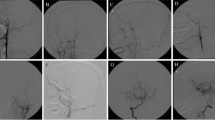Abstract
A 49-year-old woman with probable moyamoya disease was surgically treated by combined direct and indirect methods, superficial temporal to middle cerebral artery anastomosis and galeoduroencephalosynangiosis by a burr-hole method developed by Kawamoto et al. Transient ischemic attacks and motor weakness of bilateral lower extremities disappeared completely within 1 month and never recurred during 1-year follow-up. Galeoduroencephalosynangiosis by a burr-hole method appears useful for preventing ischemic damage of the territory of the anterior cerebral artery in adult patients with probable moyamoya disease.
Similar content being viewed by others
Author information
Authors and Affiliations
Additional information
Received: 6 July 2000 / Accepted: 15 November 2000
Rights and permissions
About this article
Cite this article
Kawamoto, H., Inagawa, T., Ikawa, F. et al. A modified burr-hole method in galeoduroencephalosynangiosis for an adult patient with probable moyamoya disease – case report and review of the literature. Neurosurg Rev 24, 147–150 (2001). https://doi.org/10.1007/PL00012400
Issue Date:
DOI: https://doi.org/10.1007/PL00012400




